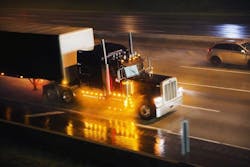New Trucking Regulation to Address Opioid Crisis
The opioid crisis has hit epidemic proportions. In 2016 more than 64,000 people died from overdoses, which is a 22% increase from 2015. Drug overdoses are now the leading cause of death for Americans under 50.
The trucking industry is dealing with the issue. In an industry meeting last May, Federal Motor Carrier Safety Administration special agent Kevin Hall said he was concerned by growth in violations by truck drivers and fleets that failed to drug test driver applicants, according to an article on MH&L by David Sparkman. Hall spoke of a case where a driver was found overdosed in the cab of his truck with the needle still in his arm—after he was fired from another carrier for failing a drug test.
A report released last year by the Governors Highway Safety Association, based on 2015 data, found that illegal drugs were present in more than 40% of fatally injured drivers for whom test results were available.
To help address this program on January 1st, new regulations from DOT went into effective which now requires testing for additional drugs. The ruling which became final in November requires employers to add four semi-synthetic opioids to the drug testing panel. This rule applies to all DOT modalities and employers in DOT-regulated industries subject to 49 CFR Part 40, such as aviation, motor carriers, railroads, mass transit and pipeline employers.
Previously, DOT-regulated employers – in addition to urine testing for amphetamines, cocaine, marijuana and phencyclidine – had only been required to test covered employees for opiates codeine, morphine and heroin.
The new DOT rule makes the following significant changes:
-- Adds four semi-synthetic opioids (hydrocodone, oxycodone, hydromorphone, and oxymorphone) to the drug testing panel
-- Adds methylenedioxyamphetamine (MDA) as an initial test analyte because, in addition to being considered a drug of abuse, it is a metabolite of methylenedioxyethylamphetaime (MDEA) and methylenedioxymethamphetamine (MDMA), and such testing potentially acts as a deterrent;
-- Removes testing for MDEA from the existing drug testing panel;
-- Removes the requirement for employers and consortium/third party administrators (C/TPAs) to submit blind specimens in order to relieve unnecessary burdens on employers
-- Adding three “fatal flaws” to the list of when a laboratory would reject a specimen and modifying the “shy bladder” process so that the collector will discard certain questionable specimens.
“Thes regulations recognize the safety issues in the trucking industry that are brought about by opioid use," explained Bob Robenalt, a partner at the Columbus office of Fisher Phillips. “These will ensure that the proper testing is being done.”
Robenalt said the need for these rules is imperative. He cited the Quest Diagnosis Index of 2016 which reported that drug use in the U.S. workforce, reached the highest positivity rate in 12 years. This was based on an analysis of more than ten million workforce drug test results.
Of course, drug testing has been around for a long time in the trucking profession and Robenahlt points out that most have protocols in place to handle this and are very adept at compliance. It’s the smaller companies that are not always well-equipped to handle compliance. He says the first action smaller companies must take is to review their fleet and make sure what their specific obligations are under DOT.
One person central to carrying out these regulations are the medical review officers. Robenahlt suggested that companies make sure that these professionals receive the training they need. For example in some cases when a test is positive the issue of consent comes into play. There might be situations where an employee’s consent is not required when reporting this information. This is the case under the DOT Rule 49 CFR Part 40 Section 20.23 which covers an employer’s responsibility. The regulation says that an employer who receives a verified positive drug test result must immediately remove the employee involved from performing safety-sensitive functions. "You must take this action upon receiving the initial report of the verified positive test result. Do not wait to receive the written report or the result of a split specimen test.”
While these rules address the immediate testing needs, the overall issue of how drugs are affecting the industry is of concern. The widespread use of opioids comes to the trucking industry at a time where the industry is already under a lot of pressure to fill vacant jobs.Having more workers unavailable, due to positive test results, is squeezing not only this industry but our economy in general. The Federal Reserve reported that opioid abuse is a factor in the overall slow GDP growth rate.
While trucking companies are concerned with screening --, last year the Federal Motor Carrier Safety Administration created a national clearinghouse for commercial drivers’ drug and alcohol test results, in order to ensure that trucking companies know the history of their drivers -- they might also need to offer truckers help in prevention and rehabilitation. Although the U.S. Department of Transportation created a list of resources to help workers get help, an industry-wide effort to address the problem is the better solution.
